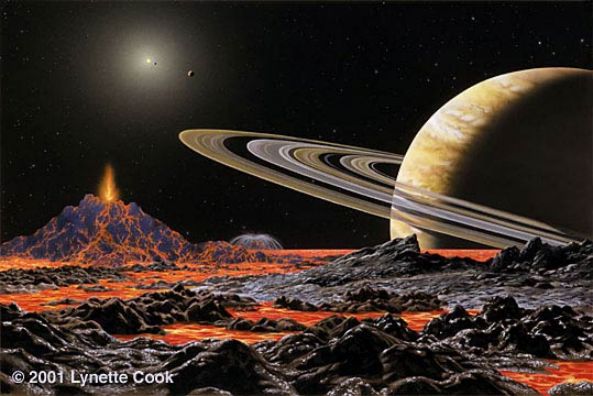Credit: Copyright 2001 Lynette Cook
Explanation:
Watching and waiting,
astronomers have uncovered the presence of more
than 70 planets orbiting stars other than the Sun.
So far almost all these
extrasolar
planets have crazy elongated orbits,
lie uncomfortably close to their parent stars, or are found in bizarre,
inhospitable systems.
Yet a reported new planet
discovery indicates for the first time that a
nearby sun-like star, 47 Ursae Majoris (47 UMa), has a system of at
least two planets in nearly circular orbits more reminiscent of
Jupiter and
Saturn in our own
familiar
Solar System.
The planets are too distant and faint to be photographed directly.
Still, 13 years of
spectroscopic observations of 47 UMa have revealed
the wobbling
signature of a second planet
intertwined with one
previously known.
In this artist's
illustration, the worlds
of 47 UMa hang over the rugged volcanic landscape of
a hypothetical moon.
The moon orbits the
newly
discovered planet, imagined here with
Saturn-like rings, while the previously known planet is visible as a
tiny crescent, close to the yellowish star.
Closer still to 47 UMa is another tiny dot, a
hypothetical Earth-like
water world.
About 51 light-years distant, 47 UMa can be found in planet Earth's
sky near the Big Dipper.
1999 2000 2001 2002 2003 2004 2005 2006 2007 2008 2009 2010 2011 2012 2013 2014 2015 2016 2017 2018 2019 2020 2021 2022 2023 2024 2025 |
Yanvar' Fevral' Mart Aprel' Mai Iyun' Iyul' Avgust Sentyabr' Oktyabr' Noyabr' Dekabr' |
NASA Web Site Statements, Warnings, and Disclaimers
NASA Official: Jay Norris. Specific rights apply.
A service of: LHEA at NASA / GSFC
& Michigan Tech. U.
|
Publikacii s klyuchevymi slovami:
extrasolar planet - Ursa Major - 47 UMa - planetary system - planet - Bol'shaya Medvedica - planetnaya sistema - Planety u drugih zvezd
Publikacii so slovami: extrasolar planet - Ursa Major - 47 UMa - planetary system - planet - Bol'shaya Medvedica - planetnaya sistema - Planety u drugih zvezd | |
Sm. takzhe:
Vse publikacii na tu zhe temu >> | |
